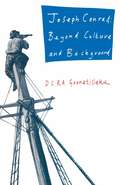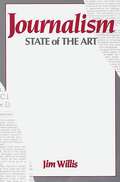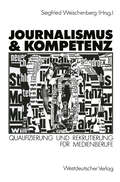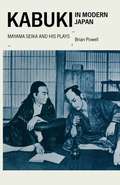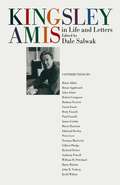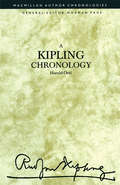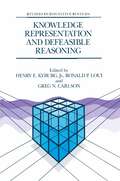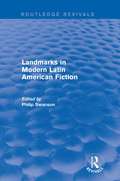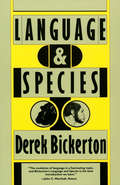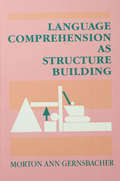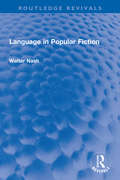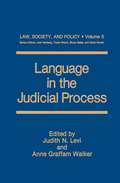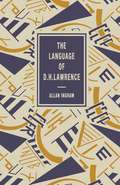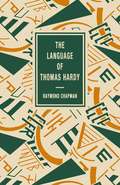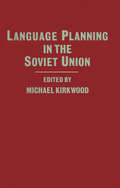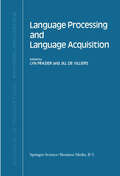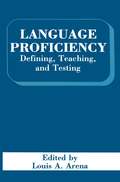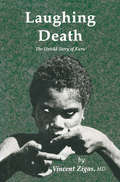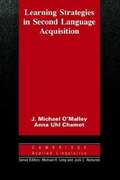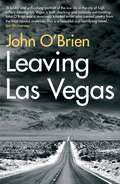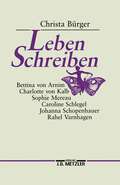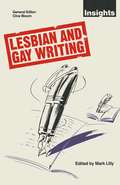- Table View
- List View
Joseph Conrad: Beyond Culture and Background (Routledge Guides To Literature Ser.)
by D C Goonetilleke Caterina SinibaldiJournalism: State of the Art
by Jim WillisA necessity for the professional journalist's library, Journalism: State of the Art will prove a valuable resource for the student journalist as well. This book summarizes some 200 media studies many from the most prestigious journal in the trade, Journalism Quarterly. In a paraphrased-synthesis format, and using informal terms, the author arranges some of the most interesting studies of the 1980s into eight subject headings including: Ethics Law, and the Journalist; Advertising in the 1980s; Polling and Precision Journalism; and Predictors of Readership and Viewship.For many years there has been a gap between media researchers and the practicing journalist. Published research about journalism as a discipline may receive attention in the classroom but seldom gets in the newsroom. Viewing the gap between the researcher and practitioner, Willis offers comments from both sides. He surveys nearly 150 news executives on media research and gives an insightful look at what factors cause readers or viewers to pay attention to the news media. From trends in the industry to types of audiences, Journalism: State of the Art uses practical research studies presented in an accessible style. Offering the most current data available on media research, this book will prove a great instructional as well as reference tool. It is a must for college journalists, working press, and media marketers.
Journalismus & Kompetenz: Qualifizierung und Rekrutierung für Medienberufe
by Siegfried WeischenbergDie Qualifizierung und Rekrutierung für Medienberufe enthält im Prozeß sozialen Wandels zu einer "Informationsgesellschaft" besondere Bedeutung. Was müssen Journalisten wissen und können, um den gestiegenen Ansprüchen an ihre Kompetenz gerecht zu werden? Wie können sich Berufsaspiranten am besten auf den Journalismus vorbereiten? Welche Vorzüge und Nachteile haben die Ausbildungswege in die Medien? Diese Fragen werden in den 15 Originalbeiträgen des Readers beantwortet. Sie enthalten nicht nur Informationen, sondern erstmals auch (empirische) Evaluationen zu allen Formen der Journalistenausbildung in der Bundesrepublik. Themen sind u.a. die in Stellenanzeigen nachgefragten Qualifikationen, die Weiterbildungsangebote für Journalisten, die Didatik der Journalistenausbildung, die Qualität der Lehrbücher zum Journalismus und die Berufschancen von Publizistik-Studenten."(...) Dem vorliegenden Reader ist das Erreichen seiner Zielsetzung voll zu bescheinigen. Er leistet - und das unterscheidet ihn durchaus von anderen einschlägigen Publikationen - eine weitreichende Problematisierung sowie vor allem empirisch gestützte Evaluation der Qualifizierung für die Medien und arbeitet damit einen bedeutenden Defizitbereich der Forschung auf. Trotz der Vielfalt der behandelten Einzelthemen bleibt der Problemzugriff insgesamt doch kohärent, was durch häufige Querverweise unterstützt wird. Berufsaspiranten, aber auch die Ausbilder selbst sollten nicht von der Lektüre dieses wichtigen Beitrags absehen."Medienwissenschaft 1/91"(...) Das Buch empfiehlt sich nicht nur für Berufsaspiranten, die sich über die diversen Ausbildungswege ein Bild verschaffen wollen, sondern auch für Journalisten, die nach Ergänzungen suchen und die Anregungen zur Reflexion über die Bedingungen ihres Berufes erwarten."Medium 1/92
Knowledge Representation and Defeasible Reasoning (Studies in Cognitive Systems #5)
by Henry E. Kyburg Jr. R. P. Loui G. N. CarlsonThis series will include monographs and collections of studies devoted to the investigation and exploration of knowledge, information, and data processing systems of all kinds, no matter whether human, (other) ani mal, or machine. Its scope is intended to span the full range of interests from classical problems in the philosophy of mind and philosophical psy chology through issues in cognitive psychology and sociobiology (concerning the mental capabilities of other species) to ideas related to artificial intelli gence and computer science. While primary emphasis will be placed upon theoretical, conceptual, and epistemological aspects of these problems and domains, empirical, experimental, and methodological studies will also ap pear from time to time. The present volume provides a collection of studies that focus on some of the central problems within the domain of artificial intelligence. These difficulties fall into four principal areas: defeasible reasoning (including the frame problem as apart), ordinary language (and the representation prob lems that it generates), the revision of beliefs (and its rules of inference), and knowledge representation (and the logical problems that are encountered there). These papers make original contributions to each of these areas of inquiry and should be of special interest to those who understand the crucial role that is played by questions of logical form. They vividly illustrate the benefits that can emerge from collaborative efforts involving scholars from linguistics, philosophy, computer science, and AI. J. H. F.
Landmarks in Modern Latin American Fiction (Routledge Revivals)
by Philip SwansonIn the 1960s, there occurred amongst Latin American writers a sudden explosion of literary activity known as the ‘Boom’. It marked an increase in the production and availability of innovative and experimental novels. But the ‘Boom’ of the 1960s should not be taken as the only flowering of Latin American fiction, for such novels dubbed ‘new novels’ were being written in the 1940s and 1950s, as well as in the 1970s and 1980s. In this edited collection, first published in 1990, Philip Swanson charts the development of Latin American fiction throughout the twentieth century. He assesses the impact of the ‘new novel’ on Latin American literature, and follows its growth. Nine key texts are analysed by contributors, including works by the ‘big four’ of the ‘Boom’ – Fuentes, Cortázar, Garcia Márquez and Vargas Llosa. This book will be of interest to critics and teachers of Latin American literature, and will be useful too as supplementary reading for students of Spanish and Hispanic Studies. It will also serve as a helpful introduction to those new to Latin American fiction.
Landmarks in Modern Latin American Fiction (Routledge Revivals)
by Philip SwansonIn the 1960s, there occurred amongst Latin American writers a sudden explosion of literary activity known as the ‘Boom’. It marked an increase in the production and availability of innovative and experimental novels. But the ‘Boom’ of the 1960s should not be taken as the only flowering of Latin American fiction, for such novels dubbed ‘new novels’ were being written in the 1940s and 1950s, as well as in the 1970s and 1980s. In this edited collection, first published in 1990, Philip Swanson charts the development of Latin American fiction throughout the twentieth century. He assesses the impact of the ‘new novel’ on Latin American literature, and follows its growth. Nine key texts are analysed by contributors, including works by the ‘big four’ of the ‘Boom’ – Fuentes, Cortázar, Garcia Márquez and Vargas Llosa. This book will be of interest to critics and teachers of Latin American literature, and will be useful too as supplementary reading for students of Spanish and Hispanic Studies. It will also serve as a helpful introduction to those new to Latin American fiction.
Language and Species
by Derek BickertonLanguage and Species presents the most detailed and well-documented scenario to date of the origins of language. Drawing on "living linguistic fossils" such as "ape talk," the "two-word" stage of small children, and pidgin languages, and on recent discoveries in paleoanthropology, Bickerton shows how a primitive "protolanguage" could have offered Homo erectus a novel ecological niche. He goes on to demonstrate how this protolanguage could have developed into the languages we speak today. "You are drawn into [Bickerton's] appreciation of the dominant role language plays not only in what we say, but in what we think and, therefore, what we are."—Robert Wright, New York Times Book Review "The evolution of language is a fascinating topic, and Bickerton's Language and Species is the best introduction we have."—John C. Marshall, Nature
Language Comprehension As Structure Building
by Morton Ann GernsbacherThis book presents a new theoretical framework -- what Gernsbacher calls the Structure Building Framework -- for understanding language comprehension in particular, and cognitive processing in general. According to this framework, the goal in comprehending both linguistic and nonlinguistic materials is to build a coherent mental representation or "structure" of the information being comprehended. As such, the underlying processes and mechanisms of structure building are viewed as general, cognitive processes and mechanisms. The strength of the volume lies in its empirical detail: a thorough literature review and solid original data.
Language Comprehension As Structure Building
by Morton Ann GernsbacherThis book presents a new theoretical framework -- what Gernsbacher calls the Structure Building Framework -- for understanding language comprehension in particular, and cognitive processing in general. According to this framework, the goal in comprehending both linguistic and nonlinguistic materials is to build a coherent mental representation or "structure" of the information being comprehended. As such, the underlying processes and mechanisms of structure building are viewed as general, cognitive processes and mechanisms. The strength of the volume lies in its empirical detail: a thorough literature review and solid original data.
Language in Popular Fiction (Routledge Revivals)
by Walter NashFirst published in 1990, Language in Popular Fiction was written to provide a comprehensive and illuminating look at the way language is used in thrillers and romantic fiction. The book examines the use of language across three interrelated levels: a level of verbal organisation, a level of narrative structure, and a level at which stylistic options and devices are related to notions of gender. It introduces ‘the protocol of pulchritude’ and makes use of detailed stylistic and linguistic analysis to investigate a wide range of ‘popfiction’ and ‘magfiction’. In doing so, it provokes serious reflection on popular fiction and its claims on the reader.
Language in Popular Fiction (Routledge Revivals)
by Walter NashFirst published in 1990, Language in Popular Fiction was written to provide a comprehensive and illuminating look at the way language is used in thrillers and romantic fiction. The book examines the use of language across three interrelated levels: a level of verbal organisation, a level of narrative structure, and a level at which stylistic options and devices are related to notions of gender. It introduces ‘the protocol of pulchritude’ and makes use of detailed stylistic and linguistic analysis to investigate a wide range of ‘popfiction’ and ‘magfiction’. In doing so, it provokes serious reflection on popular fiction and its claims on the reader.
Language in the Judicial Process (Law, Society and Policy #5)
by Judith N. Levi Anne Graffam WalkerLegal realism is a powerful jurisprudential tradition which urges attention to sodal conditions and predicts their influence in the legal process. The rela tively recent "sodal sdence in the law" phenomenon, in which sodal research is increasingly relied on to dedde court cases is a direct result of realistic jurisprudence, which accords much significance in law to empirical reports about sodal behavior. The empirical research used by courts has not, how ever, commonly dealt with language as an influential variable. This volume of essays, coedited by Judith N. Levi and Anne Graffam Walker, will likely change that situation. Language in the Judicial Process is a superb collection of original work which fits weIl into the realist tradition, and by focusing on language as a key variable, it establishes a new and provocative perspective on the legal process. The perspective it offers, and the data it presents, make this volume a valuable source of information both for judges and lawyers, who may be chiefly concemed with practice, and for legal scholars and sodal sdentists who do basic research about law.
The Language of D.H.Lawrence (Language of Literature)
by Allan IngramThis book provides a description and analysis of the most characteristic linguistic features of Lawrence's fictional prose. Use of language is placed in a context that includes the attitudes and modes of expression of the literature of Modernism, the shaping influence of Lawrence's own background, his attitude towards the novel and its purpose and potential as a form, and, above all, the artistic integrity of each novel or story. One chapter is devoted to the language of Lawrence's poetry.
Language of Thomas Hardy
by Raymond ChapmanThis study of Hardy's literary language in both fiction and poetry, attempts to show how it reflects aspects of his life and his personal beliefs. The literary effect of his distinctive phraseology and sentence-structure is exemplified and assessed.
Language Processing and Language Acquisition (Studies in Theoretical Psycholinguistics #10)
by Lyn Frazier and Jill VilliersStudies of language acqUiSItion have largely ignored processing prin ciples and mechanisms. Not surprisingly, questions concerning the analysis of an informative linguistic input - the potential evidence for grammatical parameter setting - have also been ignored. Especially in linguistic approaches to language acquisition, the role of language processing has not been prominent. With few exceptions (e. g. Goodluck and Tavakolian, 1982; Pinker, 1984) discussions of language perform ance tend to arise only when experimental debris, the artifact of some experiment, needs to be cleared away. Consequently, language pro cessing has been viewed as a collection of rather uninteresting perform ance factors obscuring the true object of interest, namely, grammar acquisition. On those occasions when parsing "strategies" have been incorporated into accounts of language development, they have often been discussed as vague preferences, not open to rigorous analysis. In principle, however, theories of language comprehension can and should be subjected to the same criteria of explicitness and explanatoriness as other theories, e. g. , theories of grammar. Thus their peripheral role in accounts of language development may reflect accidental factors, rather than any inherent fuzziness or irrelevance to the language acquisition problem. It seems probable that an explicit model of the way(s) processing routines are applied in acquisition would help solve some central problems of grammar acquisition, since these routines regulate the application of grammatical knowledge to novel inputs.
Language Proficiency: Defining, Teaching, and Testing
by Louis A. ArenaLouis A. Arena University of Delaware Newark, DE This monograph contains select, revised, and invited papers which deal with the topic, Language Proficiency: Defining, Teaching, and Testing. This topic was the theme of the eighth annual symposium held at the University of Delaware. The papers contained in this volume are invited papers or were originally scheduled for presentation and/or presented at the eighth annual Delaware Symposium on Language Studies. The papers combine research con ducted in the areas of teaching, testing, and defining second language pro ficiency within the profession of applied linguistics. They are divided into three principal sections: "Applied Linguistics and Language Pro ficiency", "Language Proficiency in Reading and Writing", and "Testing for Language Proficiency". In Part I, Paul Angelis' "Applied Linguistics: Realities and Projections re the Teaching Profession'; sketches a historical portrait of Applied Linguistics, its definition, presence, and role in the profession that teaches second language proficiency. Angelis concludes that Applied Linguistics is still a young discipline in terms of substance, organization, and strategy, and that these three components will determine the prospects for the future of applied linguistics re the teaching profession. The next six papers address the issue of second language proficiency from various points of view. Kensaku Yoshida's essay "Knowing vs Believing vs Feeling: Studies on Japanese Bilinguals" concludes that some Japanese bilinguals are actually not necessarily bilingual because they very often face problems requiring other kinds of proficiency, i. e.
Laughing Death: The Untold Story of Kuru
by Vincent ZigasIt has been a difficult, sometimes painful, story to tell in its entirety, but I have done my best to be accurate both in facts and in dates, for I feel that l owe the truth to the many who have become valued acquaintances, and sometimes friends. All these have constantly requested more news of my "Green Dwelling" and my discovery of a fatal neurological disease previously unknown to Western medicine. This book is for them, in lieu of letters that I ought to have written and did not. It is also my concern to produce innocent amusement, unrestricted by canon or precedent, for those who require some relaxation from the fatigue generated by so many parasitic forms of life in this less than perfect world.My peers, the medical scientists, who read this will realize that this book is neither a scientific treatise, nor a balance-sheet of all the achievements and failures of medical science, but a presentation of the major implications of the factors that continually determine our medical ethics - including some of the less prizeworthy drawbacks.
Learning Strategies in Second Language Acquisition (Cambridge Applied Linguistics Ser.)
by J. O'Malley Anna ChamotO'Malley and Chamot review the literature on learning strategies, describe and classify learning strategies in second language learning, and discuss why learning is affected in a positive manner when such strategies are used. The authors present instructional models for learning-strategy training that teachers can apply to their own classes. The material is based on current research in second language acquisition and cognitive theory.
Leaving Las Vegas
by John O'BrienA re-issue of John O'Brien's debut novel, a masterpiece of modern realism about the perils of addiction and love in a city of loneliness.Leaving Las Vegas, the first novel by John O'Brien, is the disturbing and emotionally wrenching story of a woman who embraces life and a man who rejects it. Sera is a prostitute, content with the independence and routine she has carved out for herself in a city defined by recklessness. But she is haunted by a spectre in a yellow Mercedes, a man from her past who is committed to taking control of her life again. Ben is an alcoholic intent on drinking his way towards an early death. Newly arrived from Los Angeles, he survived the four-hour intoxicated drive across the desert with his entire savings in his wallet and nothing else left to lose. Looking to satisfy hungers both material and existential, Ben and Sera stumble together on the strip and discover in each other a respite from their unforgiving lives. A testimony to the raw talent of its young author, Leaving Las Vegas is a compelling story of unconditional love between two disenfranchised and lost souls - an overlooked American classic.
Lesbian and Gay Writing (Insights)
by Mark LillyPart of a series which looks at contemporary criticism on neglected literary and cultural areas, this book examines the conventional academic view of lesbian/gay writing and has essays on lesbian writers as well as a section on gay men's writing. All the critical essays are by lesbians or gay men.
